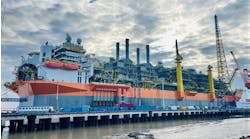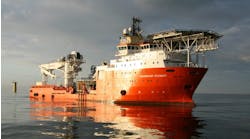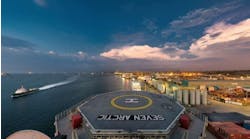Jennifer Pallanich Hull
Gulf of Mexico Editor
Following the industry focus to decrease the amount of steel necessary for floater hull fabrication, GVA Consultants has developed the Box-Top-Beam deck configuration for Gulf of Mexico applications.
The approach in the US Gulf of Mexico tends to be to add large prefabricated modules to a flat deck, leading to double layers of steel on many portions of the deck, said Pontus Clason, senior project manager. The deck box is rarely used in conventional integrated deck designs.
"You end up having a lot of steel, which is only of use during construction but adding nothing but weight during operation, frankly," he said.
The BTB design is geared primarily at the GoM because other areas prefer and make use of the advantages of integrated decks, he added.
GVA-C developed the beam-type deck design that eliminates the doubling up of steel layers, he said. The basic design resembles an H in that the legs are connected in a parallel fashion with a main center girder that is 8-10 m high rather than the typical large square connecting the four columns. Clason said this will allow the placement of modules straight on column tops instead of the elevated deck. The modules can either be lifted or floated into place.
"The main advantages are we can get the module center of gravity lower down, we can reduce the vessel size, and we reduce the steel fabrication," he said.
Bringing the design to market
According to GVA-C, the lower steel weight and center of gravity decrease vessel size, lower mooring loads, reduce cost, and, when compared to a conventional semisubmersible, lead to a 25% reduction in displacement.
Clason said the concept is fully developed, the design has been confirmed by preliminary structural analysis, and GVA-C is now performing a complete design analysis.
"We're assuring ourselves that it will work, that it's strong enough, that it will meet design requirements," he said.
null
Given the conservative nature of operators, he added, the cost savings in steel and time will probably be the driving force in introducing the concept offshore in the GoM.
According to GVA-C, the BTB deck won't require much more fabrication time than the integrated deck design. The BTB deck is suited for fabrication of deck and hull at different locations while the integrated deck is more suited for integrated deck and hull fabrication at a single location, Clason said. In terms of construction, he added, the BTB deck allows for fabrication and outfitting of the process modules in the Gulf of Mexico area while the steel hull can be fabricated elsewhere and transported to the GoM.
GVA-C faced stress flow challenges in designing the BTB deck, Clason said. The different type of stress flow in the structure, he said, will not provide the most effective steel utilization, or minimum steel weight, but he said the concept's advantages for some clients may be worth the extra cost.
GVA-C has patents pending for the BTB structure. The process modules can be installed during a floatover set-down operation or they can be lifted in place. The design's structural independence means there are no hull-loads forced into the modules.
null
The art of asymmetry
In other areas of design work for the offshore industry, GVA-C is working up an asymmetrical hull design.
Clason said the asymmetrical hull focuses on minimizing vessel motions at the riser termination point for the wave periods that are most prone to generate riser fatigue damage. While these wave periods are normally no problem to ordinary vessel operations, the relatively high occurrence of these waves will have a significant impact on the steel catenary riser fatigue life. Reducing the amplitude of the wave motions will considerably improve the design life of the deepwater risers, he said, and GVA-C has found that relatively small hull modifications can easily reduce the damaging motions by 30% to 40%. The impact on the fatigue life will vary with riser configuration, but it will definitely improve, Clason said.
"We are aimed at tailor-made design," he said. "But more important than that, we strongly believe the complete system hull-risers-moorings need to designed in a very integrated manner in order to function properly."





